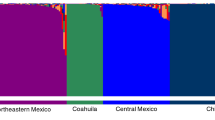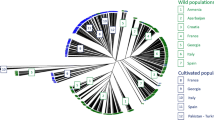Abstract
Genotypic diversity has been detected among aromatic grapevines (Vitis vinifera) by molecular markers (AFLPs). The 22 primer-pairs generated a total of 1,331 bands of which 564 (40%) were polymorphic over all the genotypes. The bootstrap analysis pointed out that a large number of polymorphic bands (200–400) has to be used for a better estimation of the genetic distances among genotypes; 383 polymorphic AFLP bands were used for the cluster and the principal coordinate analyses because they did not present missing data across all the genotypes. The cluster analysis (UPGMA), based on polymorphic AFLP markers, revealed no relationship between the Moscato and Malvasia grapevines. The Malvasias, unlike the Moscatos distinguished by their distinct muscat aroma, have to be considered a more complex group because it includes muscat and non-muscat grapevines. The principal coordinate analysis (PCO) confirmed the pattern of the cluster analysis only for those varieties which presented a low coefficient of dissimilarity, while for the other varieties there was no correspondence between the two analyses. The pattern of aggregation among aromatic grapevines in the cluster and principal coordinate analyses does not support any classification that might include an aromatic grapevine group in V. vinifera. Even though some synonyms and homonyms are present among aromatic grapevines (V. vinifera), genetic diversity exists among genotypes in AFLP markers.



Similar content being viewed by others
References
Bourquin JC, Sonko A, Otten L, Walter B (1993) Restriction fragment length polymorphism and molecular taxonomy in Vitis vinifera L. Theor Appl Genet 87:431–438
Bowers JE, Bandman EB, Meredith CP (1993) DNA fingerprint characterization of some wine grape cultivars. Am J Enol Vitic 44:266–274
Bowers JE, Dangl GS, Vignani R, Meredith CP (1996) Isolation and characterization of new polymorphic simple sequence repeat loci in grape (Vitis vinifera). Genome 39:628–633
Buscher N, Zyprian E, Bachmann O, Blaich R (1994) On the origin of the grapevine variety Muller-Thurgau as investigated by the inheritance of random amplified polymorphic DNA (RAPD). Vitis 33:15–17
Cervera MT, Cabezas JA, Sancha JC, Martinez-de-Toda F, Martinez-Zapater JM (1998) Application of AFLPs to the characterization of grapevine Vitis vinifera L. genetic resources: a case study with accessions from Rioja (Spain). Theor Appl Genet 97:51–59
Cettolini S (1893) Elenco delle principali uve sarde. Annuario R. Scuola di viticoltura e Enologia, Cagliari, Vol. III
Dalmasso G, Dell'Olio G, Malfatto P, Cosmo I, Polsinelli M, Sardi F, Prosperi V, Pirovano A, Bruni B, Breviglieri N, Casini E, Del Gaudio S, Giusto D, Panzera C, Mazzei A, Zappalá A (1964) Malvasie. In: Principali vitigni ad uva da vino coltivati in Italia. M.A.F., Roma
Dangl GS, Mendum ML, Prins BP, Walker MA, Meridith CP, Simon CJ (2001) Simple sequence repeat analysis of a clonally propagated species: a tool for managing a grape germplasm collection. Genome 44:432–438
Efron B, Tibshirani R (1991) Statistical analysis with computer age. Science 253:390–395
Fanizza G, Corona MG, Resta P (2000) Analysis of genetic relationships among Muscat grapevines in Apulia (South Italy) by RAPD markers. Vitis 39:159–161
Felsenstein J (1985) Confidence limits on phylogenies: an approach using the bootstrap. Evolution 39:783–791
Gogorcena Y, Arulsekar S, Dandekar AM, Parfitt DE (1993) Molecular markers for grape characterization. Vitis 32:183–185
Lodhi MA, Weeden NF, Reich BI (1997) Characterization of RAPD markers in Vitis. Vitis 36:133–140
Molon G (1906) Ampelografia. Hoepli U, Milano, Vol II
Nicosia G, Bambara G (1959) Il Malvasia di Lipari. In: Luigi Scialpi (ed) Estr da 'Vini d'Italia', Roma
Rohlf FJ (1997) NTSYS-pc-numerical taxonomy and multivariate analysis system. Exeter Software, Setauket, New York
Roy-Chevrier J (1900) Ampélographie rétrospective. Coulet et Fils, Montpellier
Scott KD, Ablett EM, Lee LS, Henry RJ (2001) AFLP markers distinguishing an early mutant of Flame Seedless grape. Euphytica 113:245–249
Sefc KM, Lopez MS, Lefort F, Botta R, Roubelakis-Agelalakis KA, Ibanez I, Pejie HW, Wagner J, Glossl H, Stein-Kellner H (2000) Microsatellite variability in grapevine cultivars from different European region and evaluation of assignment testing to assess the geographic origin of the cultivar. Theor Appl Genet 100:489–505
Sensi E, Vignani R, Rohde W, Biricolti S (1996) Characterization of genetic biodiversity with Vitis vinifera L. Sangiovese and Colorino genotypes by AFLP and ISTR DNA marker technology. Vitis 35:183–188
Sneath PHA, Sokal RR (1973) Numerical taxonomy. WH Freeman and Company, San Francisco
Stavrakakis MN, Biniari K (1998) Genetic study of grape cultivars belonging to the muscat family by random amplified polymorphic DNA markers. Vitis 37:119–122
Thomas MS, Cain P, Scott NS (1994) DNA typing of grapevines: a universal methodology and database for describing cultivars and evaluating genetic relatedness. Plant Mol Biol 25:937–949
Tivang JG, Nienhuis J, Smith OS (1994) Estimation of sampling variance of molecular marker data sites using the bootstrap procedure. Theor Appl Genet 89:259–264
Viala P, Vermorel V (1909) Ampélographie. Masson et C, Paris, Tome VII
Vos P, Hogers R, Bleeker M, Reijans M, Van De Lee T, Hornes M, Frijters A, Pot J, Peleman J, Kuiper M, Zabeau M (1995) AFLP: a new technique for DNA fingerprinting. Nucleic Acids Res 23:4407–4414
Xiamping Q, Lu J, Lamikanra O (1996) Genetic diversity in Muscadine and American bunch grapes based on random amplified polymorphic DNA (RAPD) analysis. J Am Soc Hort Sci 121:1020–1023
Yap IV, Nelson RJ (1996) WINBOOT. A program for performing bootstrap analysis of binary data to determine the confidence limits of the UPGMA-based dendrogram. IRRI Discussion Paper Ser No. 14, International Rice Research Institute, Los Banos, The Philippines
Author information
Authors and Affiliations
Corresponding author
Additional information
Communicated by H.F. Linskens
Rights and permissions
About this article
Cite this article
Fanizza, G., Chaabane, R., Lamaj, F. et al. AFLP analysis of genetic relationships among aromatic grapevines (Vitis vinifera). Theor Appl Genet 107, 1043–1047 (2003). https://doi.org/10.1007/s00122-003-1354-5
Received:
Accepted:
Published:
Issue Date:
DOI: https://doi.org/10.1007/s00122-003-1354-5




